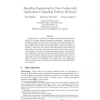Free Online Productivity Tools
i2Speak
i2Symbol
i2OCR
iTex2Img
iWeb2Print
iWeb2Shot
i2Type
iPdf2Split
iPdf2Merge
i2Bopomofo
i2Arabic
i2Style
i2Image
i2PDF
iLatex2Rtf
Sci2ools
ALGORITHMICA
2008
2008
Algorithm Engineering for Color-Coding with Applications to Signaling Pathway Detection
Color-coding is a technique to design fixed-parameter algorithms for several NP-complete subgraph isomorphism problems. Somewhat surprisingly, not much work has so far been spent on the actual implementation of algorithms that are based on color-coding, despite the elegance of this technique and its wide range of applicability to practically important problems. This work gives various novel algorithmic improvements for color-coding, both from a worst-case perspective as well as under practical considerations. We apply the resulting implementation to the identification of signaling pathways in protein interaction networks, demonstrating that our improvements speed up the color-coding algorithm by orders of magnitude over previous implementations. This allows more complex and larger structures to be identified in reasonable time; many biologically relevant instances can even be solved in seconds where, previously, hours were required.
| Added | 08 Dec 2010 |
| Updated | 08 Dec 2010 |
| Type | Journal |
| Year | 2008 |
| Where | ALGORITHMICA |
| Authors | Falk Hüffner, Sebastian Wernicke, Thomas Zichner |
Comments (0)

